tailgate FIAT 500 2018 Owner handbook (in English)
[x] Cancel search | Manufacturer: FIAT, Model Year: 2018, Model line: 500, Model: FIAT 500 2018Pages: 224, PDF Size: 3.89 MB
Page 15 of 224
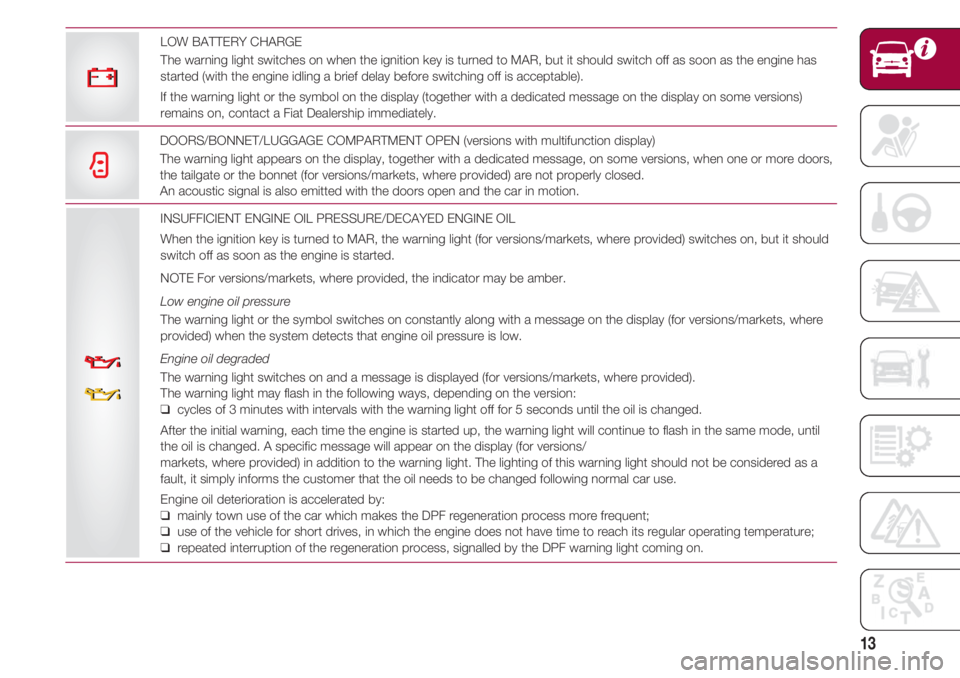
13
INSUFFICIENT ENGINE OIL PRESSURE/DECAYED ENGINE OIL
When the ignition key is turned to MAR, the warning light (for versions/markets, where provided) switches on, but it should
switch off as soon as the engine is started.
NOTE For versions/markets, where provided, the indicator may be amber.
Low engine oil pressure
The warning light or the symbol switches on constantly along with a message on the display (for versions/markets, where
provided) when the system detects that engine oil pressure is low.
Engine oil degraded
The warning light switches on and a message is displayed (for versions/markets, where provided).
The warning light may flash in the following ways, depending on the version:
❑ cycles of 3 minutes with intervals with the warning light off for 5 seconds until the oil is changed.
After the initial warning, each time the engine is started up, the warning light will continue to flash in the same mode, until
the oil is changed. A specific message will appear on the display (for versions/
markets, where provided) in addition to the warning light. The lighting of this warning light should not be considered as a
fault, it simply informs the customer that the oil needs to be changed following normal car use.
Engine oil deterioration is accelerated by:
❑ mainly town use of the car which makes the DPF regeneration process more frequent;
❑ use of the vehicle for short drives, in which the engine does not have time to reach its regular operating temperature;
❑ repeated interruption of the regeneration process, signalled by the DPF warning light coming on.
vv
vv
DOORS/BONNET/LUGGAGE COMPARTMENT OPEN (versions with multifunction display)
The warning light appears on the display, together with a dedicated message, on some versions, when one or more doors,
the tailgate or the bonnet (for versions/markets, where provided) are not properly closed.
An acoustic signal is also emitted with the doors open and the car in motion.
ww
LOW BATTERY CHARGE
The warning light switches on when the ignition key is turned to MAR, but it should switch off as soon as the engine has
started (with the engine idling a brief delay before switching off is acceptable).
If the warning light or the symbol on the display (together with a dedicated message on the display on some versions)
remains on, contact a Fiat Dealership immediately.
Page 16 of 224

KNOWING YOUR CAR
14
R
S
DOORS/BONNET/LUGGAGE COMPARTMENT OPEN (colour display)
The symbols appear on the display, together with a dedicated message, on some versions, when one or more doors, the
tailgate or the bonnet
(for versions/markets, where provided) are not properly closed.
An acoustic signal is also emitted with the doors open and the car in motion.
R
S
“DUALOGIC” GEARBOX FAULT (for versions/markets, where provided)
When the ignition key is turned to MAR, the warning light switches on but should switch off after a few seconds.
The warning light comes on flashing, along with a dedicated message on the display and an acoustic signal, to indicate a
gearbox fault.
SEAT BELTS NOT FASTENED
The warning light switches on constantly with the vehicle stationary and the driver’s side or passenger side seat belt
(when the passenger is present) not fastened.
The warning light will flash and a buzzer will sound if the car is in motion and the front seat belts are not correctly fastened.
For permanent deactivation of the acoustic signal (buzzer) of the S.B.R. (Seat Belt Reminder) system contact
a Fiat Dealership. The system can be reactivated at any time using the Setup Menu.
<<
EBD FAULT (Multifunction display)
The simultaneous switching on of the warning lights with the engine on indicates either a failure of the EBD system or that
the system is not available. In this case, the rear wheels may suddenly lock and the vehicle may swerve when braking
sharply.
On some versions the display shows the dedicated message.
Drive very carefully to a Fiat Dealership to have the system inspected.
x
>x
>
Page 29 of 224

27
HEADLIGHT
ALIGNMENT
With the ignition key at MAR and
dipped beam headlights on, press the
+ button to adjust the headlights
upwards and the – button to adjust the
headlights downwards.
TYRE RESET (ITPMS
RESET)
(for versions/markets, where provided)
With this function it is possible to reset
the iTPMS (see paragraph “iTPMS”). To
carry out the Reset procedure proceed
as follows:
❒ briefly press the MENU
N; the
display will show “Reset”;
❒ press button + or – to select (“Yes”
or “No”); a dedicated reset
confirmation message will appear;
❒ briefly press the MENU
N; the
display will show “Confirm”;
THE KEYS1)
1) 1)
CODE CARD
(for versions/markets, where provided)
The car is delivered with two copies of
the ignition key and with the CODE
card fig. 7 which bears the following:
A: the electronic code;
B: the mechanical key code to be given
to the Fiat Dealership when ordering
duplicate keys.
You should have the electronic code
with you at all times.
IMPORTANT All the keys and the
CODE card must be handed over to
the new owner when selling the car.
MECHANICAL KEY
The metal insert A-fig. 8 operates:
❒ the ignition switch;
❒ the door locks and the tailgate (for
versions/markets, where provided);
❒ the locking/unlocking of the fuel
cap.
KEY WITH REMOTE
CONTROL
(for versions/markets, where provided)
The metal insert A-fig. 9 operates:
❒ the ignition switch;
❒ the door locks;
❒ the locking/unlocking of the fuel
cap.
7DVDF0S0103c
8DVDF0S0104c
Page 30 of 224
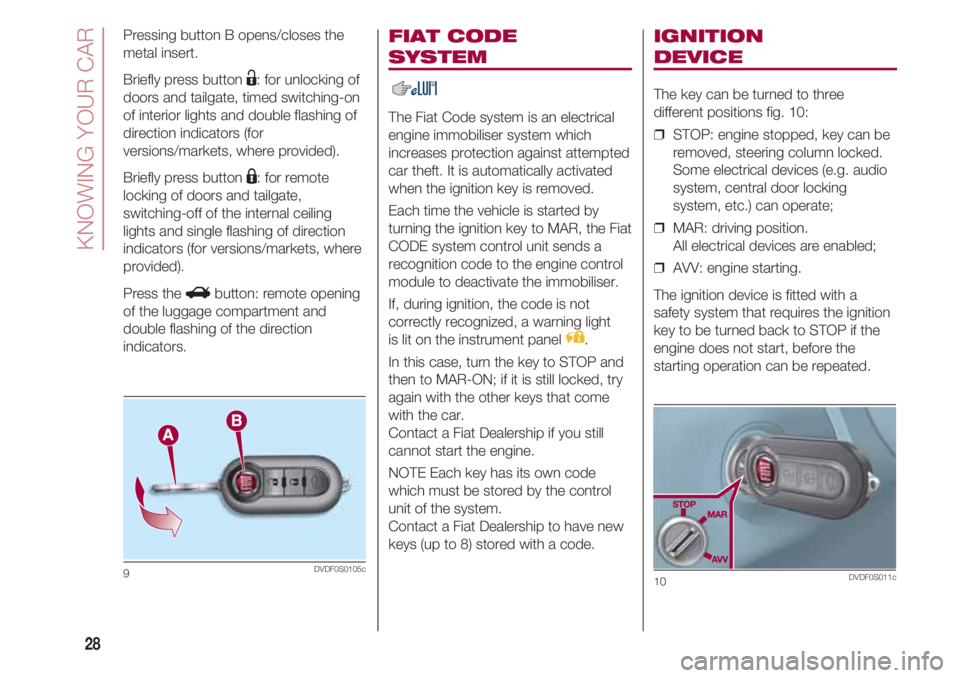
KNOWING YOUR CAR
28
FIAT CODE
SYSTEM
The Fiat Code system is an electrical
engine immobiliser system which
increases protection against attempted
car theft. It is automatically activated
when the ignition key is removed.
Each time the vehicle is started by
turning the ignition key to MAR, the Fiat
CODE system control unit sends a
recognition code to the engine control
module to deactivate the immobiliser.
If, during ignition, the code is not
correctly recognized, a warning light
is lit on the instrument panel .
In this case, turn the key to STOP and
then to MAR-ON; if it is still locked, try
again with the other keys that come
with the car.
Contact a Fiat Dealership if you still
cannot start the engine.
NOTE Each key has its own code
which must be stored by the control
unit of the system.
Contact a Fiat Dealership to have new
keys (up to 8) stored with a code.
IGNITION
DEVICE
The key can be turned to three
different positions fig. 10:
❒ STOP: engine stopped, key can be
removed, steering column locked.
Some electrical devices (e.g. audio
system, central door locking
system, etc.) can operate;
❒ MAR: driving position.
All electrical devices are enabled;
❒ AVV: engine starting.
The ignition device is fitted with a
safety system that requires the ignition
key to be turned back to STOP if the
engine does not start, before the
starting operation can be repeated.
10DVDF0S011c
Pressing button B opens/closes the
metal insert.
Briefly press button
Ë: for unlocking of
doors and tailgate, timed switching-on
of interior lights and double flashing of
direction indicators (for
versions/markets, where provided).
Briefly press button
Á: for remote
locking of doors and tailgate,
switching-off of the internal ceiling
lights and single flashing of direction
indicators (for versions/markets, where
provided).
Press the Rbutton: remote opening
of the luggage compartment and
double flashing of the direction
indicators.
9DVDF0S0105c
Page 47 of 224
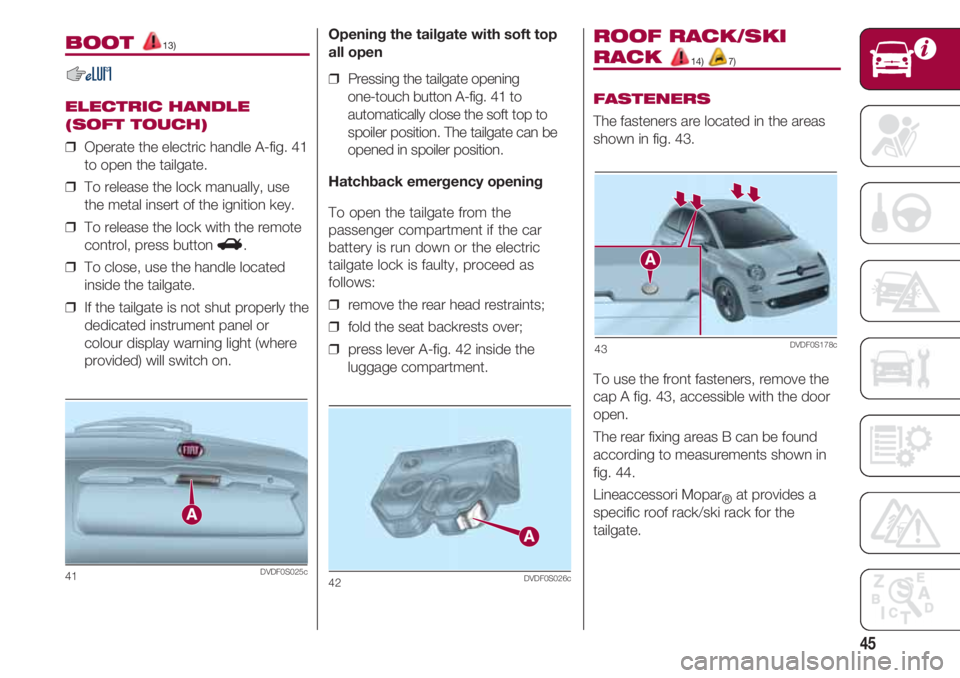
45
BOOT 13)
ELECTRIC HANDLE
(SOFT TOUCH)
❒ Operate the electric handle A-fig. 41
to open the tailgate.
❒ To release the lock manually, use
the metal insert of the ignition key.
❒ To release the lock with the remote
control, press button R.
❒ To close, use the handle located
inside the tailgate.
❒ If the tailgate is not shut properly the
dedicated instrument panel or
colour display warning light (where
provided) will switch on.
41DVDF0S025c
Opening the tailgate with soft top
all open
❒ Pressing the tailgate opening
one-touch button A-fig. 41 to
automatically close the soft top to
spoiler position. The tailgate can be
opened in spoiler position.
Hatchback emergency opening
To open the tailgate from the
passenger compartment if the car
battery is run down or the electric
tailgate lock is faulty, proceed as
follows:
❒ remove the rear head restraints;
❒ fold the seat backrests over;
❒ press lever A-fig. 42 inside the
luggage compartment.
42DVDF0S026c
ROOF RACK/SKI
RACK 14) 7)
FASTENERS
The fasteners are located in the areas
shown in fig. 43.
To use the front fasteners, remove the
cap A fig. 43, accessible with the door
open.
The rear fixing areas B can be found
according to measurements shown in
fig. 44.
Lineaccessori Mopar
®at provides a
specific roof rack/ski rack for the
tailgate.
43DVDF0S178c
Page 141 of 224
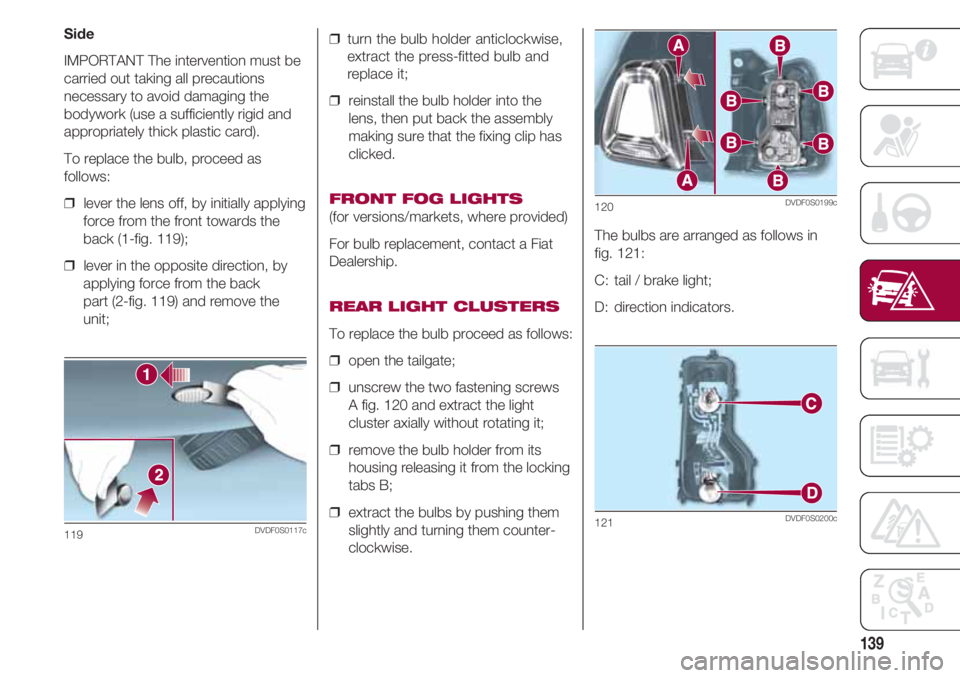
139
Side
IMPORTANT The intervention must be
carried out taking all precautions
necessary to avoid damaging the
bodywork (use a sufficiently rigid and
appropriately thick plastic card).
To replace the bulb, proceed as
follows:
❒ lever the lens off, by initially applying
force from the front towards the
back (1-fig. 119);
❒ lever in the opposite direction, by
applying force from the back
part (2-fig. 119) and remove the
unit;
119DVDF0S0117c
❒ turn the bulb holder anticlockwise,
extract the press-fitted bulb and
replace it;
❒ reinstall the bulb holder into the
lens, then put back the assembly
making sure that the fixing clip has
clicked.
FRONT FOG LIGHTS
(for versions/markets, where provided)
For bulb replacement, contact a Fiat
Dealership.
REAR LIGHT CLUSTERS
To replace the bulb proceed as follows:
❒ open the tailgate;
❒ unscrew the two fastening screws
A fig. 120 and extract the light
cluster axially without rotating it;
❒ remove the bulb holder from its
housing releasing it from the locking
tabs B;
❒ extract the bulbs by pushing them
slightly and turning them counter-
clockwise.The bulbs are arranged as follows in
fig. 121:
C: tail / brake light;
D: direction indicators.
120DVDF0S0199c
121DVDF0S0200c
Page 190 of 224
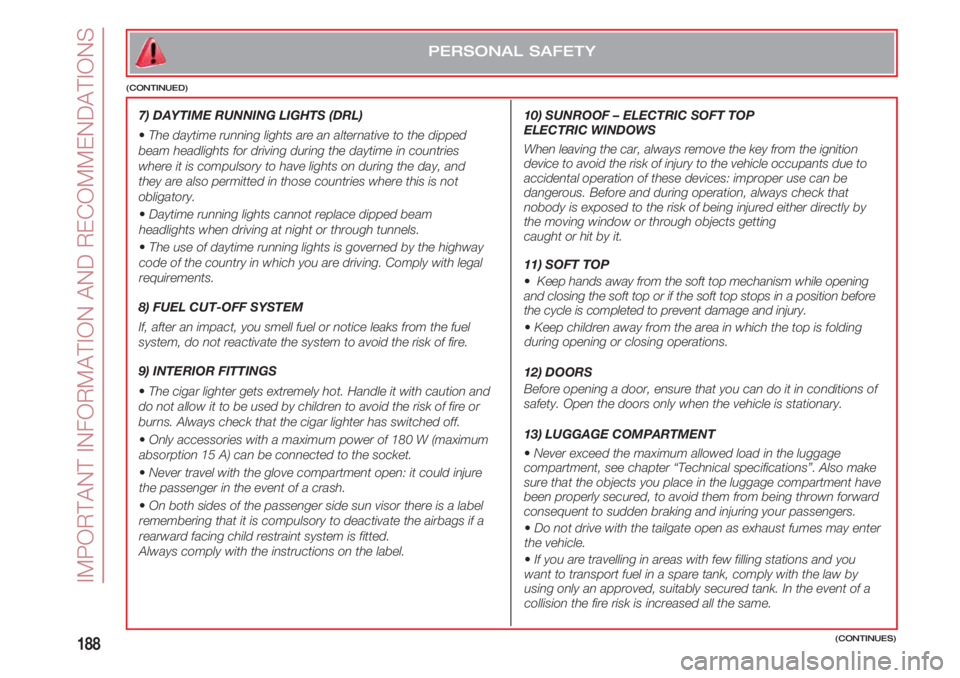
IMPORTANT INFORMATION AND RECOMMENDATIONS
188(CONTINUES)
PERSONAL SAFETY
(CONTINUED)
7) DAYTIME RUNNING LIGHTS (DRL)
•The daytime running lights are an alternative to the dipped
beam headlights for driving during the daytime in countries
where it is compulsory to have lights on during the day, and
they are also permitted in those countries where this is not
obligatory.
•Daytime running lights cannot replace dipped beam
headlights when driving at night or through tunnels.
•The use of daytime running lights is governed by the highway
code of the country in which you are driving. Comply with legal
requirements.
8) FUEL CUT-OFF SYSTEM
If, after an impact, you smell fuel or notice leaks from the fuel
system, do not reactivate the system to avoid the risk of fire.
9) INTERIOR FITTINGS
•The cigar lighter gets extremely hot. Handle it with caution and
do not allow it to be used by children to avoid the risk of fire or
burns. Always check that the cigar lighter has switched off.
•Only accessories with a maximum power of 180 W (maximum
absorption 15 A) can be connected to the socket.
•Never travel with the glove compartment open: it could injure
the passenger in the event of a crash.
•On both sides of the passenger side sun visor there is a label
remembering that it is compulsory to deactivate the airbags if a
rearward facing child restraint system is fitted.
Always comply with the instructions on the label.10) SUNROOF – ELECTRIC SOFT TOP
ELECTRIC WINDOWS
When leaving the car, always remove the key from the ignition
device to avoid the risk of injury to the vehicle occupants due to
accidental operation of these devices: improper use can be
dangerous. Before and during operation, always check that
nobody is exposed to the risk of being injured either directly by
the moving window or through objects getting
caught or hit by it.
11) SOFT TOP
•Keep hands away from the soft top mechanism while opening
and closing the soft top or if the soft top stops in a position before
the cycle is completed to prevent damage and injury.
•Keep children away from the area in which the top is folding
during opening or closing operations.
12) DOORS
Before opening a door, ensure that you can do it in conditions of
safety. Open the doors only when the vehicle is stationary.
13) LUGGAGE COMPARTMENT
•Never exceed the maximum allowed load in the luggage
compartment, see chapter “Technical specifications”. Also make
sure that the objects you place in the luggage compartment have
been properly secured, to avoid them from being thrown forward
consequent to sudden braking and injuring your passengers.
•Do not drive with the tailgate open as exhaust fumes may enter
the vehicle.
•If you are travelling in areas with few filling stations and you
want to transport fuel in a spare tank, comply with the law by
using only an approved, suitably secured tank. In the event of a
collision the fire risk is increased all the same.
Page 191 of 224

189(CONTINUES)
PERSONAL SAFETY
(CONTINUED)
•When opening the tailgate, take care not to hit possible
objects on the roof rack.
•Make sure the backrests are properly secured at both sides
to prevent them from moving forward, in the event of sharp
braking, with possible impact with of the passengers.
14) ROOF RACK/SKI RACK
•Fully comply with the regulations in force concerning
maximum clearance.
•Never exceed the maximum permitted loads; see chapter
“Technical specifications”.
•Evenly distribute the load and take into account, when
driving, the increased responsiveness of the vehicle to side
wind. After travelling for a few kilometres, check to ensure that
the fixing screws for the attachments are well tightened.
•Before driving, make sure that the transversal bars have been
fitted properly.
15) ABS SYSTEM – ESC SYSTEM
•The ABS gets the most from the available grip, but it cannot
improve it; you should therefore take every care when driving on
slippery surfaces and not take unnecessary risks.
•When the ABS cuts in and you feel the brake pedal pulsating,
do not remove your foot, but keep the pedal pushed down; in
doing so you, will stop in the shortest distance possible under
the road conditions at the time.
•If the ABS system intervenes, this indicates that the traction of
the tyres on the road is nearing its limit. You must slow down to
a speed compatible with the available traction.
• To obtain the maximum efficiency of the braking system, a
bedding-in period of about 500 km is needed: during this period
it is better to avoid sharp, repeated and prolonged braking. • The ABS, ESC and ASR systems cannot overrule the natural
laws of physics, and cannot increase the grip available according
to the condition of the road.
• The ABS, ESC, ASR and HBA systems cannot prevent
accidents, including those due to excessive speed on corners,
driving on low-grip surfaces or aquaplaning.
• The capability of the ABS, ESC, ASR and HBA systems must
never be tested irresponsibly and dangerously, in such a way as
to compromise personal safety and the safety of others.
•When the Mechanical Brake Assist intervenes, noises may be
heard from the system.
This is normal. In any case, while braking keep the brake pedal
firmly depressed.
•If only the
xwarning light on the instrument panel lights up
(together with a message in the multifunction display, for
versions/markets, where provided) stop the vehicle immediately
and contact the nearest Fiat Dealership. Fluid leaking from the
hydraulic system will compromise the operation of the braking
system, whether it is of the conventional type or with ABS.
•Do not take unnecessary risks, even if your vehicle is fitted with
the ESC and ASR systems.
Your driving style must always be suited to the road conditions,
visibility and traffic. The driver is always responsible for road
safety.
•If the space-saver wheel (where provided) is used, the ABS,
ASR and ESC systems keep operating.
Always remember that the space-saver wheel, being smaller than
the original wheel provides less grip.
•For correct operation of the ABS, ESC and ASR systems, the
tyres must absolutely be of the same brand and type on all
wheels, in perfect conditions and, above all, of type, brand and
size specified.
Page 204 of 224

IMPORTANT INFORMATION AND RECOMMENDATIONS
202
1) KEYS AND CODE CARD
•The electronic components inside the key may be damaged if
the key is subjected to strong shocks. In order to ensure
complete efficiency of the electronic devices inside the keys,
they should never be exposed to direct sunlight.
•All the keys and the CODE card must be handed over to the
new owner when selling the car.
2) SEATS
•The fabric upholstery of the seats has been designed to
withstand long-term wear deriving from normal use of the car.
Some precautions are however required. Avoid prolonged and/or
excessive rubbing against clothing accessories such as metal
buckles and Velcro strips which, by applying a high pressure on
the fabric in a small area, could cause it to break, thereby
damaging the upholstery.
•Before tilting the backrest, remove any objects on the seat
cushion.
3) CLIMATE CONTROL SYSTEM
Never use R12 coolant, which is not compatible with climate
control system components.
4) WINDSCREEN AND REAR WINDOW WIPER
•Do not use the windscreen or rear window wiper to remove
layers of snow or ice from the windscreen. In such conditions,
the windscreen and rear window wiper may be subjected to
excessive stress and the motor cut-out switch, which prevents
operation for a few seconds, may intervene. If operation is not restored, contact a Fiat Dealership.
•Do not operate the windscreen wiper with the blades lifted from
the windscreen:
• Do not activate the rain sensor or the rearscreen wiper when
washing the car in an automatic car wash.
• Make sure that the device is turned off if there is ice on the
windscreen.
5) SUNROOF
•Use the sunroof only at “spoiler” position if a transverse roof
rack is fitted.
•Do not open the sunroof if there is snow or ice on it: you may
damage it.
•Be careful not to hit objects on the storage shelf when you
open the tailgate.
6) SOFT TOP
•Never open the top in presence of snow or ice to prevent
damage.
•Do not place objects on the rear window shelf to prevent
damage while the top is closing.
•Loads may not be secured on the roof.
•Bird droppings must be washed off immediately and thoroughly
as the acid they contain is particularly aggressive.
•Never use high-pressure washing systems.
•When using steam washers or high-pressure water washers,
maintain a suitable distance and do not exceed a maximum
temperature of 60°C.
Damage, alterations and water infiltrations may occur if the
distance is too small.
•If a water jet is used, direct away from the edges of the fabric
and the rear window frame to prevent water infiltrations.
VEHICLE SAFETY
(CONTINUES)
Page 205 of 224
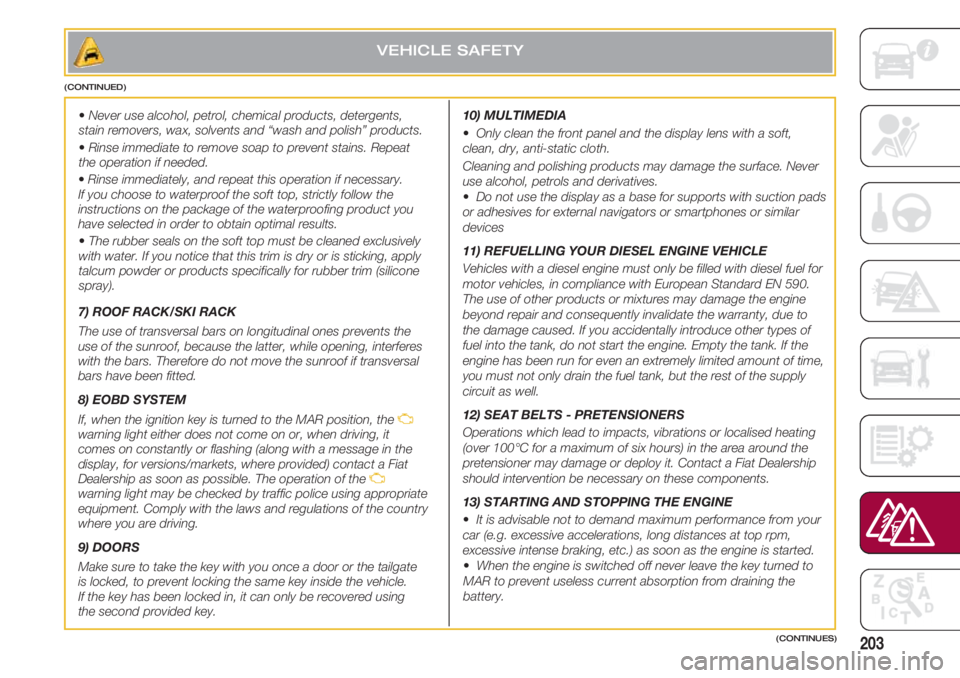
203
•Never use alcohol, petrol, chemical products, detergents,
stain removers, wax, solvents and “wash and polish” products.
•Rinse immediate to remove soap to prevent stains. Repeat
the operation if needed.
•Rinse immediately, and repeat this operation if necessary.
If you choose to waterproof the soft top, strictly follow the
instructions on the package of the waterproofing product you
have selected in order to obtain optimal results.
•The rubber seals on the soft top must be cleaned exclusively
with water. If you notice that this trim is dry or is sticking, apply
talcum powder or products specifically for rubber trim (silicone
spray).
7) ROOF RACK/SKI RACK
The use of transversal bars on longitudinal ones prevents the
use of the sunroof, because the latter, while opening, interferes
with the bars. Therefore do not move the sunroof if transversal
bars have been fitted.
8) EOBD SYSTEM
If, when the ignition key is turned to the MAR position, the
Uwarning light either does not come on or, when driving, it
comes on constantly or flashing (along with a message in the
display, for versions/markets, where provided) contact a Fiat
Dealership as soon as possible. The operation of the
Uwarning light may be checked by traffic police using appropriate
equipment. Comply with the laws and regulations of the country
where you are driving.
9) DOORS
Make sure to take the key with you once a door or the tailgate
is locked, to prevent locking the same key inside the vehicle.
If the key has been locked in, it can only be recovered using
the second provided key.10) MULTIMEDIA
• Only clean the front panel and the display lens with a soft,
clean, dry, anti-static cloth.
Cleaning and polishing products may damage the surface. Never
use alcohol, petrols and derivatives.
• Do not use the display as a base for supports with suction pads
or adhesives for external navigators or smartphones or similar
devices
11) REFUELLING YOUR DIESEL ENGINE VEHICLE
Vehicles with a diesel engine must only be filled with diesel fuel for
motor vehicles, in compliance with European Standard EN 590.
The use of other products or mixtures may damage the engine
beyond repair and consequently invalidate the warranty, due to
the damage caused. If you accidentally introduce other types of
fuel into the tank, do not start the engine. Empty the tank. If the
engine has been run for even an extremely limited amount of time,
you must not only drain the fuel tank, but the rest of the supply
circuit as well.
12) SEAT BELTS - PRETENSIONERS
Operations which lead to impacts, vibrations or localised heating
(over 100°C for a maximum of six hours) in the area around the
pretensioner may damage or deploy it. Contact a Fiat Dealership
should intervention be necessary on these components.
13) STARTING AND STOPPING THE ENGINE
• It is advisable not to demand maximum performance from your
car (e.g. excessive accelerations, long distances at top rpm,
excessive intense braking, etc.) as soon as the engine is started.
• When the engine is switched off never leave the key turned to
MAR to prevent useless current absorption from draining the
battery.
VEHICLE SAFETY
(CONTINUES) (CONTINUED)